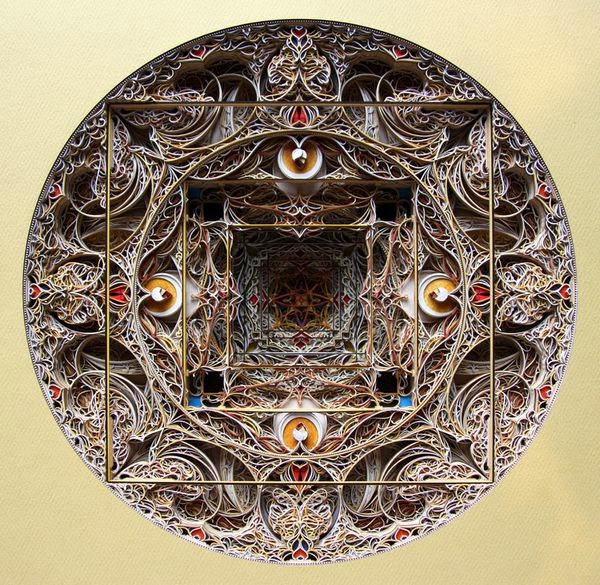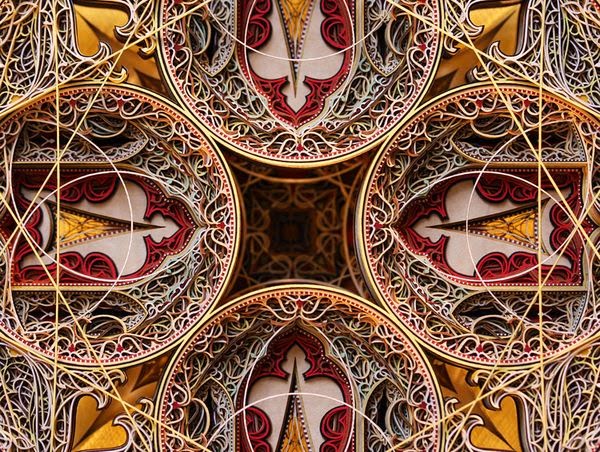The Burlington, Vermont-based artist wrote on his website that Build the Future was originally a proof of concept for a larger-scale typography project for a startup headquarters. Somewhere along the way Winslow made it into a “personal mantra.”
“Taking actual objects from my childhood was important to the concept of the project but equally painful and exciting to paint white and make new,” he wrote on his website. Winslow posted a video of the project on Vimeo, where he offered up more details on the project.
Since project typography plays with personal perspective, Winslow wanted to exploit multiple viewing angles. As the sculpture rotates on a cylindrical surface, not unlike vinyl spinning on a record player, a multi-colored “cyclical message” is revealed. As the message resolves throughout its full revolution, there are also intermittent moments of abstraction.
"For the past few years I've been focusing on blending physical and digital mediums, so similar to a pixel screen print series of mine, I wanted this project to appear digital, but be completely analog," Winslow told The Creators Project. "This typographic projection technique has been seen recently in a music video by OK Go and the intro to Apple's recent keynote.
“The message is a simple one: it’s hard to let go of the past, but I propose a different solution,” Winslow wrote. “Look at your past and build from it, create a better future for yourself and others.”
“[M]ost people become tied down by objects, stuff, and things,” he added. “By selecting childhood possessions and essentially destroying to make something new, I took a strong step to build on and recontextualize the memories they contain, while freeing them the box they would otherwise live in.”
For more of Winslow's work, head to his website here.



![As for technique, Winslow initially used 3D software to discover a method for outputting vector graphics to be installed on a larger scale, but when the startup project startup fell through, he settled on a very hands-on method. This required mounting the projector to a specific location, with the composition of white objects to another, and then pencilling in and painting each projection where the shadows fell off the objects. “The message is a simple one: it’s hard to let go of the past, but I propose a different solution,” Winslow wrote. “Look at your past and build from it, create a better future for yourself and others.” “[M]ost people become tied down by objects, stuff, and things,” he added. “By selecting childhood possessions and essentially destroying to make something new, I took a strong step to build on and recontextualize the memories they contain, while freeing them the box they would otherwise live in.” As for technique, Winslow initially used 3D software to discover a method for outputting vector graphics to be installed on a larger scale, but when the startup project startup fell through, he settled on a very hands-on method. This required mounting the projector to a specific location, with the composition of white objects to another, and then pencilling in and painting each projection where the shadows fell off the objects. “The message is a simple one: it’s hard to let go of the past, but I propose a different solution,” Winslow wrote. “Look at your past and build from it, create a better future for yourself and others.” “[M]ost people become tied down by objects, stuff, and things,” he added. “By selecting childhood possessions and essentially destroying to make something new, I took a strong step to build on and recontextualize the memories they contain, while freeing them the box they would otherwise live in.”](https://blogger.googleusercontent.com/img/b/R29vZ2xl/AVvXsEiv9YQHTcIL-XqDXs7nk1xJ8lwu4P62haI1CBl-fsYX3LtSDS7YEJq8N_w69yV_ALbWwCf_SL0ewHh3xqaDZL1KgOeL9n9Ho40zK4HPDWd1PPfoPhQHDpyLCzpmMScK2ulP4wzgffa_cAJA/s1600/3.gif)
![As for technique, Winslow initially used 3D software to discover a method for outputting vector graphics to be installed on a larger scale, but when the startup project startup fell through, he settled on a very hands-on method. This required mounting the projector to a specific location, with the composition of white objects to another, and then pencilling in and painting each projection where the shadows fell off the objects. “The message is a simple one: it’s hard to let go of the past, but I propose a different solution,” Winslow wrote. “Look at your past and build from it, create a better future for yourself and others.” “[M]ost people become tied down by objects, stuff, and things,” he added. “By selecting childhood possessions and essentially destroying to make something new, I took a strong step to build on and recontextualize the memories they contain, while freeing them the box they would otherwise live in.” As for technique, Winslow initially used 3D software to discover a method for outputting vector graphics to be installed on a larger scale, but when the startup project startup fell through, he settled on a very hands-on method. This required mounting the projector to a specific location, with the composition of white objects to another, and then pencilling in and painting each projection where the shadows fell off the objects. “The message is a simple one: it’s hard to let go of the past, but I propose a different solution,” Winslow wrote. “Look at your past and build from it, create a better future for yourself and others.” “[M]ost people become tied down by objects, stuff, and things,” he added. “By selecting childhood possessions and essentially destroying to make something new, I took a strong step to build on and recontextualize the memories they contain, while freeing them the box they would otherwise live in.”](https://blogger.googleusercontent.com/img/b/R29vZ2xl/AVvXsEgP1Xdq6oJdShda1zTxYAf0oDci-Vu87B4Z088VSOumGhhHyS2riO6lsoSzyA3pv-vgulcEAupCQzB2vIG8LTspq5PmCT9EhY2-lfxqVN9aKrN0_GtWV0k_H18bHxQe5lbo4uFnfVR4R2rl/s1600/4.gif)











_result.jpg)































